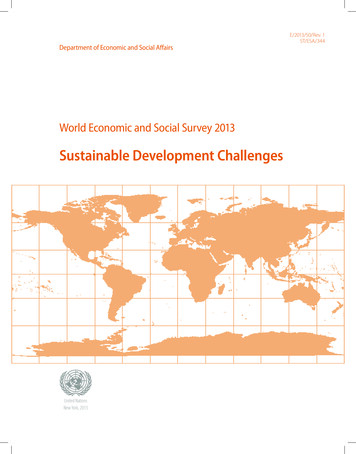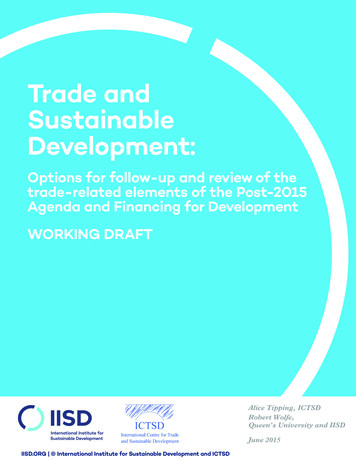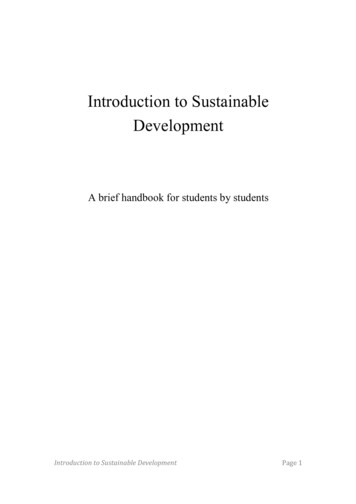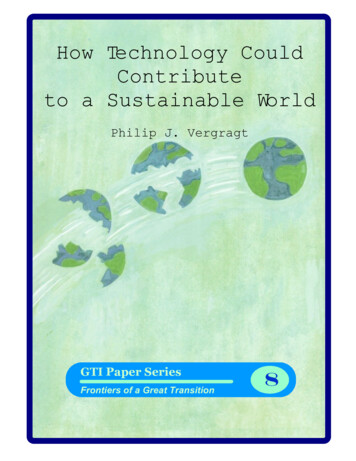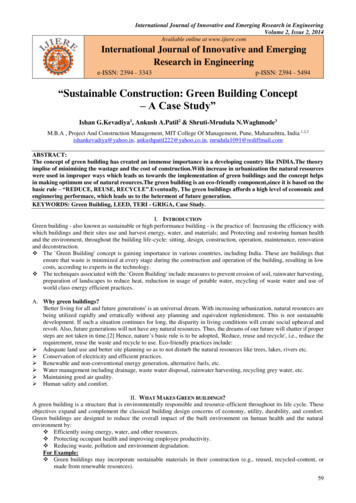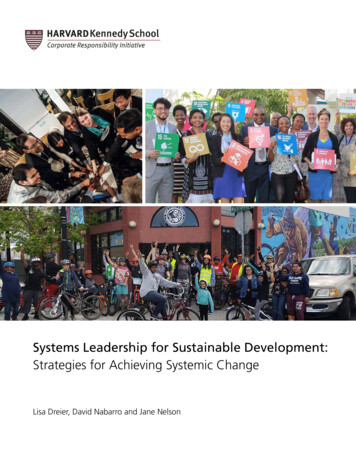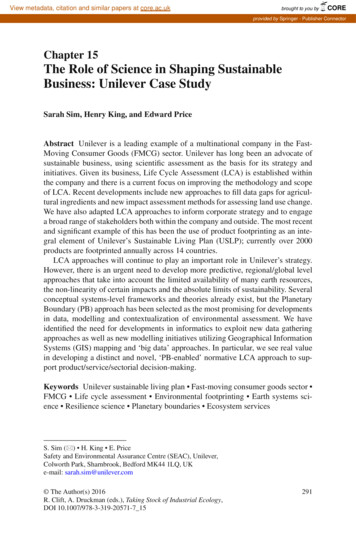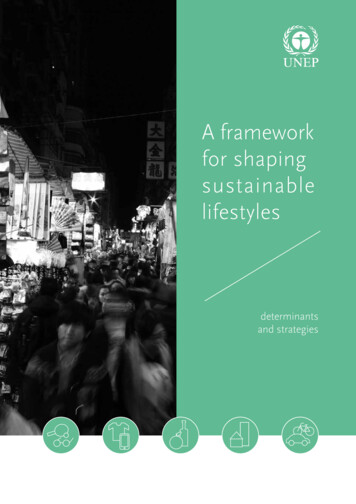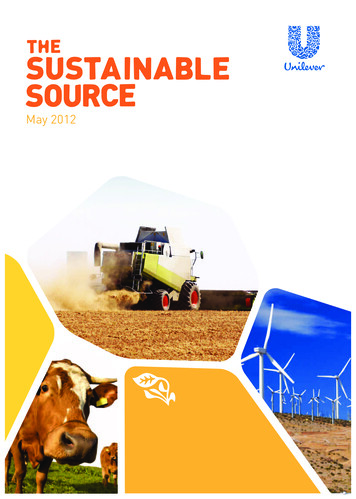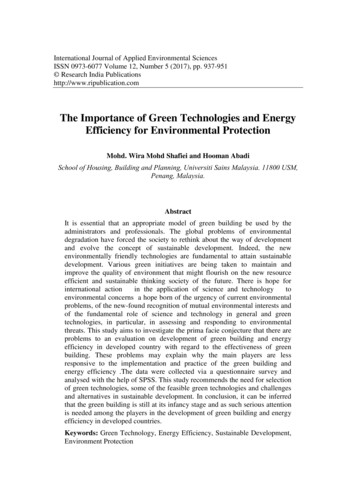
Transcription
International Journal of Applied Environmental SciencesISSN 0973-6077 Volume 12, Number 5 (2017), pp. 937-951 Research India Publicationshttp://www.ripublication.comThe Importance of Green Technologies and EnergyEfficiency for Environmental ProtectionMohd. Wira Mohd Shafiei and Hooman AbadiSchool of Housing, Building and Planning, Universiti Sains Malaysia. 11800 USM,Penang, Malaysia.AbstractIt is essential that an appropriate model of green building be used by theadministrators and professionals. The global problems of environmentaldegradation have forced the society to rethink about the way of developmentand evolve the concept of sustainable development. Indeed, the newenvironmentally friendly technologies are fundamental to attain sustainabledevelopment. Various green initiatives are being taken to maintain andimprove the quality of environment that might flourish on the new resourceefficient and sustainable thinking society of the future. There is hope forinternational actionin the application of science and technologytoenvironmental concerns a hope born of the urgency of current environmentalproblems, of the new-found recognition of mutual environmental interests andof the fundamental role of science and technology in general and greentechnologies, in particular, in assessing and responding to environmentalthreats. This study aims to investigate the prima facie conjecture that there areproblems to an evaluation on development of green building and energyefficiency in developed country with regard to the effectiveness of greenbuilding. These problems may explain why the main players are lessresponsive to the implementation and practice of the green building andenergy efficiency .The data were collected via a questionnaire survey andanalysed with the help of SPSS. This study recommends the need for selectionof green technologies, some of the feasible green technologies and challengesand alternatives in sustainable development. In conclusion, it can be inferredthat the green building is still at its infancy stage and as such serious attentionis needed among the players in the development of green building and energyefficiency in developed countries.Keywords: Green Technology, Energy Efficiency, Sustainable Development,Environment Protection
938Mohd. Wira Mohd Shafiei and Hooman Abadi1.0 INTRODUCTIONEconomic development is closely linked with the energy development. Most of theworld's commercial energy supplies are provided by fossil fuels, with the associatedemissions causing global environmental problems [28]. It is feared that not only theselevels of energy production and use from current energy sources are difficult toachieve but also unsustainable. Therefore, energy use efficiency needs to be increasedto moderate the growth of energy while the contribution from clean energy sourcesneeds to be increased to reduce adverse environmental impacts of energy usage [3].Green energy offers a promising alternative to traditional energy sources. The factthat renewable energy accounts for only a modest proportion in meeting the world's(commercial) energy demand means that there is a missing link in their potential andtheir implementation - the barriers in their implementation [6]. These barriers (eitherfinancial or non financial) need to be identified and addressed in order to designinnovative policy approaches for the international and domestic financing orrenewable energy technologies[4]. Renewable energy can play an important role inhelping to meet basic energy needs through the use of modern technologies Greentechnologies [1]. The Rio Declaration adopted at United Nations conference onEnvironment and Development in Rio emphasizes entitlement of healthy andproductive human life in harmony with integration of environment protection in thedevelopment process. The Earth Summit at Rio adopted Agenda 21 on June 14, 1992,which proposes various actions to be implemented from now and into the 21st centuryto accelerate sustainable development [2].The green technology policy to provide direction and motivation to continuouslyenjoy good quality and a healthy environment should be based on four pillars [10]: Energy: Seek to attain energy independence and promote efficient utilization. Environment: Conserve and minimize the impact on the environment. Economy: Enhance the national economic development through the use oftechnology. Social: Improve the quality of life for all.1.1 Green TechnologyGreen technology (GT) is a broad term and a field of new innovative ways to makeenvironmental friendly changes in daily life. It is created and used in a way thatconserves natural resources and the environment. It is meant as an alternative sourceof technology that reduces fossil fuels and demonstrates less damage to the human,animal, and plant health, as well as damage to the world [20]. The use of greentechnology is supposed to reduce the amount of waste and pollution that are createdduring production and consumption. It is also referred to as environmental technologyand clean technology [18].
The Importance of Green Technologies and Energy Efficiency 939Although it is difficult to precisely define the areas that are covered by greentechnology, it can safely be said that “GT is the development and application ofproducts, equipment and systems used to conserve the natural environment andresources, which minimizes and reduces the negative impact of human activities."This technology should meet the needs of society in ways that can continueindefinitely into the future without damaging or depleting natural resources [5]. Inshort, GT is defined as the technology that meets present needs without compromisingthe ability of future generations to meet their own needs.1.2 Sustainable DevelopmentThe World Commission on the Environment and Development also known as theBrundtland Commission, in their report, “Our Common Future” introduced anddefined the term sustainable development as the process in which the exploitation ofnatural resources, the allocation of investments, and the process of technologicaldevelopment and organizational change are in harmony with each other for bothcurrent and future generations. Based on this context, “sustainability” is considered asa path forward that allows humanity to meet current environmental and human health,economic, and societal needs without compromising the progress and success offuture generations [29].Some of the definitions of sustainable development illustrating the variety of foci are: Development that meets the needs of the present without compromising theability of future generations? To meet their own needs “The World Commissionon Environment and Development, Our Common Future [30]. “Improves the quality of human life while living within the carrying capacity ofsupporting ecosystems," International Union for the Conservation of Nature andNatural Resources (lUCN), World Conservation Union, United NationsEnvironment Programme (UNEP), and worldwide fund for Nature (WWF),Caring for the Earth [30].1.3 Criteria for Selection of Green TechnologiesThe Green technology is the knowledge for conserving natural environment andresources and reducing human involvement. It can operate in diversified areas such asbio-fuel, eco-forestry, renewable energy, and solid waste management [17]. However,it is neither viable nor required to adopt all the available technologies at one timewithout considering country-specific strengths and weaknesses. The selection of toolsand techniques as an appropriate technology is an important element in helpingcommunities to decide what their future should be like. In other words, appropriatetechnology's search for those technologies that have beneficial effects on incomedistribution, human development, environmental quality, and the distribution ofpolitical power [14].
940Mohd. Wira Mohd Shafiei and Hooman AbadiIn general, the seven criteria have been proposed to judge the appropriateness oftechnology by Robert (1998) in his paper entitled, “Design Criteria for SustainableDevelopment in Appropriate Technology: Technology as if People Matter” [24].A) System Independence: It is the ability of the technological device to stand alonefor doing the required job. Whether the technology will require relatively more capitalor labour will be analysed to check system independence of the technology [21].B) Image of Modernity: People should perceive themselves as modern by adoptingthe technology. The message is people’s realization that technological device canelevate the user’s social status as well as need a basic human need. Image ofmodernity requires that the social status of people who adopt it either increases orremains unchanged.C) Individual Technology vs. Collective Technology: It is the criteria to look into thesocietal/cultural standards in which the technology operates. In other words, it is thecareful assessment of the technology that is based on group approach and becomesmore systems dependent. A society geared towards individual or single family unitwill need more systems independent technology. Collective technologies are moreeasily adopted as collective action reduces a transaction cost [12].D) Cost of Technology: Affordability of the technology is an important indicator fortheir wider use since cost is the major factor in encouraging or discouraging theapplication of appropriate technology in developing economies.E) Risk Factor: It is an important factor to find out how smoothly technology worksin the local production system and system that explains to what degree is thetechnology system dependent or system independent. This indicates the need forunderstanding two types of risk- boththe internal and external risk.Although analysis of risk is necessary before applying new technology, it is almostimpossible to remove all risks.F) Evolutionary Capacity of Technology: If the chosen device is static, it willrelatively reflect the short-lived solutions to a much larger problem. The technology,which supports the continuation of development by enhancing capability to expand,can be expected to compete at the regional, national and international level.G) Single-Purpose and Multi-Purpose Technology: In contrast to single purposetechnology, multipurpose technologies are the ones that furnish a variety ofapplications (e.g. a tiller who can be used for tilling the land, powering water pump,and drying rice) [24].1.4 Feasible Green TechnologiesSome of the selected renewable-energy technologies are:A) Solar Photovoltaic: Solar photovoltaic technology converts sunlight into electricityusing semi conductor modules. Used generally for meeting lighting requirements,
The Importance of Green Technologies and Energy Efficiency 941they can also be used for pumping water, refrigeration, communication, and chargingbatteries. Solar photovoltaic has application as the green agricultural energy sourcefor pumping water, street lighting in villages, lighting in rural houses and pestmanagement [4]. Since the technology efficiently produces low-cost, high-powerphotovoltaic cells, this new generation of solar energy can be one of the mostaffordable and efficient energy sources in the future.B) Wind Energy: Wind energy is in a boom cycle. Its importance is increasing in thesense that comparatively with other sources; the wind energy produces fewer airpollutants or greenhouse gases. Wind turbine for electricity or mechanical powergeneration is a proven technology [25]. Available in 75% of the world, wind turbinesof sizes ranging from 900 W to 50 kW can be applied off-grid for pumping andtreating drinking water, irrigation, telecommunications, homes, schools, clinics andfor supplementing larger power stations [4]. Wind turbines used in pumping water forirrigation can increase agricultural growth without carbon emission.C) Bio-fuel: Bio-fuel as bio-ethanol and bio diesel has the potential to assume animportant portfolio in the future energy platter. Caution is mandatory in evaluatingbio-fuel as green agricultural technology. Food security concerns and risks toenvironment and bio diversity are parameters that necessarily need to be accessedwhile analyzing sustainability linkage of agriculture and bio-fuel. Furthermore,conversion of the wasteland to farmland with some crop options can be viewed aspositive impacts.D) Biogas: Bio gas is the product of anaerobic digestion of organic matters bymethanogenic bacteria. Bio gas qualifies on the merits that this technology utilizesorganic agricultural waste and converts it to fuel and fertilizer. Direct impacts of biogas are fuel-wood, agriculture residue, livestock manure, and kerosene savings.Increases in soil fertility and crop production have also been observed. Bio gas alsosolves the problem of indoor air pollution and improves household or communalsanitation. India's bio gas potential is estimated to be 12 million bio gas plants. Nepalcarries the potential of 1.9 million bio gas plants. In Malaysia Palm Oil Mill, Effluent(POME) can generate 177 MW [11] and China can generate 4 billion cubic meters ofbio gas [6].E) Micro & Small Hydropower: National convention of renewable hydropowervaries across nations. Hydropower plants ranging from maximum capacity of 500 kWin Nepal to 25 MW in India are conceived renewable. Generally used in ruralelectrification, hydropower plants can take an equally important role in facilitatingirrigation and value addition at source of agricultural products.F) Biomass: Agriculture residues and wastes are converted to electric and thermalenergy through processes like combustion, gasification, and cogeneration. Biomasstechnologies compliment mainstream crop production and reduce or completelyreplace consumption of traditional fuel. Experiences of some of the countries portray
Mohd. Wira Mohd Shafiei and Hooman Abadi942biomass to be effective means of increasing agricultural revenue and conservingexhaustible resources.G) Solar Thermal, Improved Water Mill, and Geothermal Energy: These cleantechnologies are found to contribute in adding value to agriculture products. Foodprocessing, animal husbandry, dairy, and aquaculture are identified sectors forapplication of solar water heating and researches on solar drying of agro products,including paddy, coffee beans, tobacco, groundnuts, banana, bamboo, rubber, etc.have been carried out in Malaysia [11].1.5 RecommendationsThe recommendations are grouped into three action areas:I.II.III.Generating new sources of revenues to fund green technologiesIntensifying dialogue on existing national green policiesSpurring new international co-operation on green technologies.I. Generate new sources of revenues to fund green technologies: Greentechnologies not yet price competitive with fossil-fuel technologies. Governmentsmust help in cutting-edge clean technologies and create the framework conditions thatenable renewable-energy companies to bring their products to the market. Hence, akey task of any government must be to generate new sources of private and publicrevenues. Where possible, governments should try to generate incentives foradditional private investment in clean-technology research and projects; when privatemarkets fail, public spending must play a role.The key recommendations to generate new sources of revenues are:1. Expand the share of green financing of public financial institutions. Public financialinstitutions, such as the European Investment Bank (EIB) or the World Bank, shouldmake the financing of renewable energy projects a priority and provides at least 20%of new loans for energy efficiency and renewable energy [17].2. Establish new international sources of climate funding. A portion of nationalemission allowances (AAUs) should be auctioned under the UNFCCC system ortaxes on air tickets, etc. to fund international initiatives. These systems should beestablished in a way that combines internationally binding financing obligations forcountries while maintaining the final budgetary responsibility of countries andparliaments to ensure political viability.3. Issue government-backed “green bonds” to make use of socially responsibleinvestments. Public finance institutions and governments should start to jointlydevelop a market for “green bonds." These bonds are issued by public financeinstitutions (such as KfW) and backed by governments to attract retail investors atreduced interest rates [24]. A strong incentive for consumers to buy green bondswould be to make their yields/coupon payments tax-free [20].
The Importance of Green Technologies and Energy Efficiency 943II. Intensify dialogue on existing national green policiesIndividual countries could profit from other countries’ experiences. Best practicesshouldbe copied while wrong paths do not need to be taken. At the centreof the discussion should be the following topics:1. Extend public procurement of clean technology. Large-scale government purchasesand deployments of green technologies will reduce the public sector’s carbonfootprint and spur private investment.2. Lead the way by cutting taxes on green products and send a strong message allaround to countries. Once the public budget allows for such a measure, more taxdeduction incentives for green services and products should be given [23].III. Spur new international co-operation on green technologiesIn the light of the various International communique, the following steps should betakento create a more effective framework for international cleantechnology cooperation:1. Create a Clean tech Investment Forum: The online forum would serve as a one-stophub with an efficient search system connecting public money, private investors, andclean tech business/entrepreneurs at one’s fingertips.2. Harmonize green technology standards, codes and contractual principles:Supranational harmonization of standards is important in enabling the uptake of ecoinnovation and clean technologies and facilitating their dissemination in globalmarkets. In many cases, regulations and standards are more effective than directgovernment funding.3. Create a best-practices expert panel on green technologies: An international panelof stakeholders and experts should define, and advise on, best. In its effort to definethe elements of successful policy frameworks for encouraging green technology, thepanel needs to take into account regional, geographic and socioeconomic differencesamong countries and sub-regions.4. Improve the knowledge sharing ability of multi-industry multi-technology cleantech research centers: No centralization of research should be pursued rather abundling of expertise from leading universities and institutes in order to enhancecooperation between regional research centers.5. Define legitimate forms of public “green” aid and reduce environmentally harmfulsubsidies: Uniform definitions of what constitutes legitimate green objectives for stateaid will help avoid judicial challenges. To ensure that public spending achieve climategoals without running afoul of state-aid rules and trading agreements, variouscountries should take the initiative [22].6. Open and sustain the markets for green technologies through better trade policy: Tofacilitate the expansion of the cleanest technologies, trade barriers for proven clean
Mohd. Wira Mohd Shafiei and Hooman Abadi944technologies should be lifted, including discontinuing direct or hidden subsidies tomanufacturers [25].2.0RESEARCH METHODOLOGYIn this research, quantitative analysis is used to analyze the data. This study analyzesdata which include descriptive statistics, goodness of measures, reliability analysis,validity analysis, hypothesis testing and mediation effects testing. It investigatesrelationships between Awareness of Environment, Technology, Social Element,Legislation and Green Building Performance. The data collection resources (tools) areclassified into two groups of primary and secondary sources or information. In thecase of secondary resources, articles, books, researches, studies and the thesesconducted in this field (collected from libraries and internet websites) have been used.Also, the primary information has been collected using the field research method(questionnaire).A draft of the questionnaire is evaluated by ten academic professors in the areas ofGBI and Green Building in Malaysian building Industry. These processes enable aresearcher to develop a questionnaire with high content validity. according to ourrespondents who are a group of experts,where all the ambiguities in the questionnairewere made clear and items have been designed and reviewed. A structuredquestionnaire is according to a 5-point (Likert-type) scale ranging from 1 to 5 namelyStrongly Disagree, Disagree, Neither Disagree nor Agree, Agree and Strongly Agree.Because, the Likert scale makes available more information about the respondents'degree of contribution, it can make available deeper implications of the perception tobe surveyed. Table 1 shows the reliability coefficient of the questionnaire. It showsthat the Cronbach's alpha of the questionnaire is 0.8235 which means the reliability ofthe present research questionnaire is acceptable. (Cronbach, 1951).Table 1: Reliability StatisticsCronbach's AlphaN of Items0.823539Sampling technique in this research is stratified sampling, where, the researcherdivides the population into separate groups, called strata. Then, a probability sample(often a simple random sample) is drawn from each group. The sample size ofresearch can be determined according to Morgan's Table. In this research populationsize is N 800 and According to Morgan’s Table the sample size should be n 260 butcould were collected 266 (33.25%). The target population of this research consistedof managers and non-managerial staff and professional members of green buildingindex (GBI).
The Importance of Green Technologies and Energy Efficiency 2.1945Analysis and InterpretationThis part discusses the objectives of the research, namely the effects of GBI inMalaysian Building Companies. In data analysis part, the collected data andsummarized information, are studied, categorized and tested using the descriptive andinferential statistical techniques in order to achieve the research objectives, answer itsquestions/hypotheses and its problems as well as the detailed process of how it workswill be explained.2.2Mahalanobis DistanceMahalanobis distances provide a powerful method of measuring how similar some setof conditions is to an ideal set of conditions, and can be very useful for identifyingwhich regions in a landscape are most similar to some “ideal” landscape. Moreover,Mahalanobis distances are based on both the mean and variance of the predictorvariables, plus the covariance matrix of all the variables, and therefore take advantageof the covariance among variables. The region of constant Mahalanobis distancearound the mean forms an ellipse in 2D space (i.e. when only 2 variables aremeasured), or an ellipsoid or hyperellipsoid when more variables are used (refer toTable 2).Table 2: Residuals StatisticsMinimum MaximumPredicted ValueStd. Predicted ValueStandard Error of Predicted ValueAdjusted Predicted ValueResidualStd. ResidualStud. ResidualDeleted ResidualStud. Deleted ResidualMahal. DistanceCook's DistanceCentered Leverage 531.000.00000.000.25.504.096MeanStd. 660266a Dependent Variable: dvThe tests results show that minimum is for Mahalanobis distance (23.095) andmaximum for Mahalanobis distance is (25.504). It means that, our data value isbetween min and max range.
Mohd. Wira Mohd Shafiei and Hooman Abadi9462.3 Skewness and Kurtosis Test ResultsSkewness and Kurtosis it can be used to test the normality of a given data set. Sincethe statistics is between (-2, 2) means that the distribution of the sample is normal.The amount of skewness for all variables respectively is -0.590, -0.391, -0.277, -0.592and -1.365. Its shows these variables were normal and symmetric distribution.The amount of kurtosis for all variables respectively are -0.040, -0.657, -0.644, -0.467and 1.872.Its shows that variables distribution is normal (refer to Table 3).Table 3: Descriptive Statistics to Skewness and KurtosisNStatisticDVIV1IV2IV3IV4Valid N (listwise)266266266266266266SkewnessStatisticStd. 9KurtosisStatisticStd. 2.4 The Regression Test among Independent Variables (Awareness ofEnvironment, Technology, Social Element, Legislation) and Dependent Variable(Green Building Performance)Multiple linear regression (MLR) is a method used to model the linear relationshipbetween a dependent variable and one or more independent variables. The dependentvariable is sometimes also called the predictand, and the independent variables thepredictors. MRA to identify the significant factors that affect of green buildingperformance on Malaysian green building. Analysis of Variance (ANOVA) showsthat factors identified by this analysis together significantly related to the dependentvariable. This means that the factors identified in this analysis are significantly relatedto the green building performance (refer to Table 4). If there is a change in the factors,there will be change in the green building performance.Below Table shows the individual factors relationship with the dependent variable ofthe regression model. It shows that all impact factors such as, awareness ofenvironment (2.035); technology (2.744), social element (2.774) and legislation(5.599) are significantly related to the green building performance.
The Importance of Green Technologies and Energy Efficiency 947Table 4: The Regression Test among IVs and DVIVDV (Green Building areness 1712.7740.0062.7440.005Social 1610.469R Square.147AdjustedR Square.1340.350St d. Error ofthe Estimate.374645.599DurbinWatson2.285ConstantSig R R2F0.147Sig0.383at0.000aBeta11.236BModel SummaryDurbin-Watson2.2850.000a. Predictors: (Constant), legislation, social building, awareness ofenv ironment , technologyb. Dependent Variable: DAs observed in the above table, since the obtained sig in ANOVA table is smaller than0.05 (0.00 0.05), the whole regression has the required statistical validity. In the nextstage, the effects of independent variable on the dependent variable are assessed. TheBeta coefficient and significance value (sig) of the variables imply that all of theindependent variables have statistical validity, because the significance value of thesevariables are smaller than the significant level 0.05. - Unstandardized ModelY 3.698 (0.181 x1) (0.310 x2) (0.223x3) (0.469 x4) - Standardized ModelY (0.124 x1) (0.171 x2) (0.161 x3) (0.350 x4)Y Dependent Variable (green building performance)x1 Independent Variable1x2 Independent Variable2x3 Independent Variable 3x4 Independent Variable 42.5 Pearson’s Correlation CoefficientThe Pearson Product-Moment Correlation Coefficient is a measure of the linearcorrelation (dependence) between two variables X and Y, giving a value between 1and 1 inclusive, where 1 is total positive correlation, 0 is no correlation, and 1 istotal negative correlation. It is widely used in the sciences as a measure of the degreeof linear dependence between two variables. It was developed by Karl Pearson from a
Mohd. Wira Mohd Shafiei and Hooman Abadi948related idea introduced by Francis Galton in the 1880s. Early work on the distributionof the sample correlation coefficient was carried out by Anil Kumar Gain and R. A.Fisher from the University of Cambridge. Pearson's correlation coefficient is definedbetween two random variables equal to their variance divided by the standarddeviation (refer to Table 5).Table 5: Correlation Pearson Coefficient Test between Variables(c1, c2, c3, c4 and c5).IndependentVariables(IV)Awareness ofEnvironmentTechnologySocial ElementLegislationDependent Variable(DV)(Green Building Performance)Pearson Correlation0.227 **Sig. (2-tailed)0.000Pearson Correlation0.137*Sig. (2-tailed)0.03Pearson Correlation0.271**Sig. (2-tailed)0.000Pearson Correlation0.399Sig. (2-tailed)0.000**. Correlation is significant at the 0.01 level (2-tailed).*. Correlation is significant at the 0.05 level (2-tailed).Statistical Hypotheses:Null Hypothesis (H0): There is no significant positive relationship between c1 and c2,c3, c4 and c5.Hypothesis A: There is significant positive relationship between c1 and c2, c3, c4 andc5.Test results: Considering that the significance levels are smaller than 0.05, the nullhypothesis is rejected and therefore hypothesis A is accepted .There is significantpositive relationship between Dependent Variable and Independent Variables.3.0 CONCLUSIONThe environmental protection, resource conservation and addressing other socioeconomic aspects for sustainable development are essential. The green initiativesadopted for resource conservation, and environmental protection shall help sustainhigher economic growth rate necessary to fulfill basic needs with some acceptablequality of life in the future. According to Brundtland Commission (1983), sustainabledevelopment is the development that meets the needs of the present without
The Importance of Green Technologies and Energy Efficiency 949compromising the ability of future generations to meet their own needs. Sustainabledevelopment that is respectful of the social equity and environmental healthiness mayoccur only when it gets stronger international awareness and large-scale changes intotendencies in production and consumption patterns. Recognizing the debilitating andeven devastating – impact of climate change,
The Importance of Green Technologies and Energy Efficiency for Environmental Protection . Mohd. Wira Mohd Shafiei and Hooman Abadi . School of Housing, Building and Planning, Universiti Sains Malaysia. 11800 USM, Penang, Malaysia. Abstract . It is essential that an appropriat
